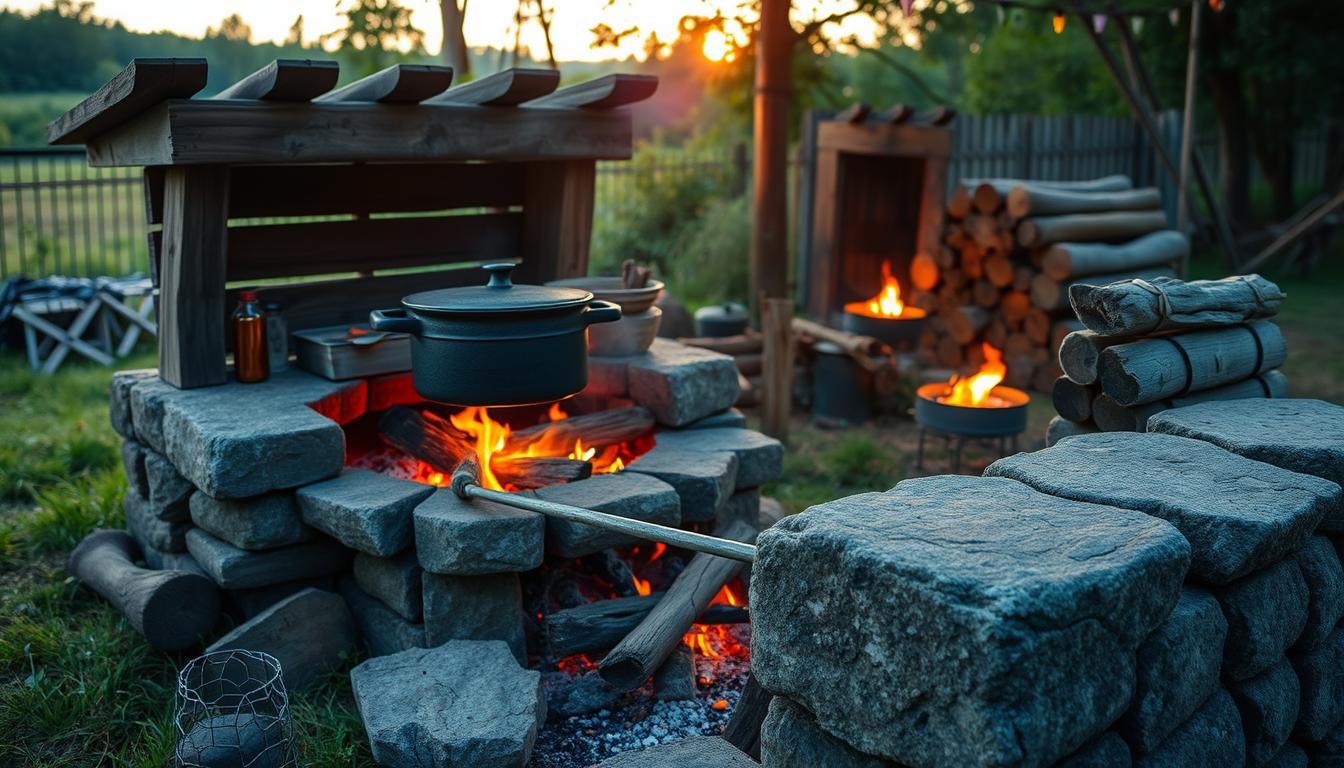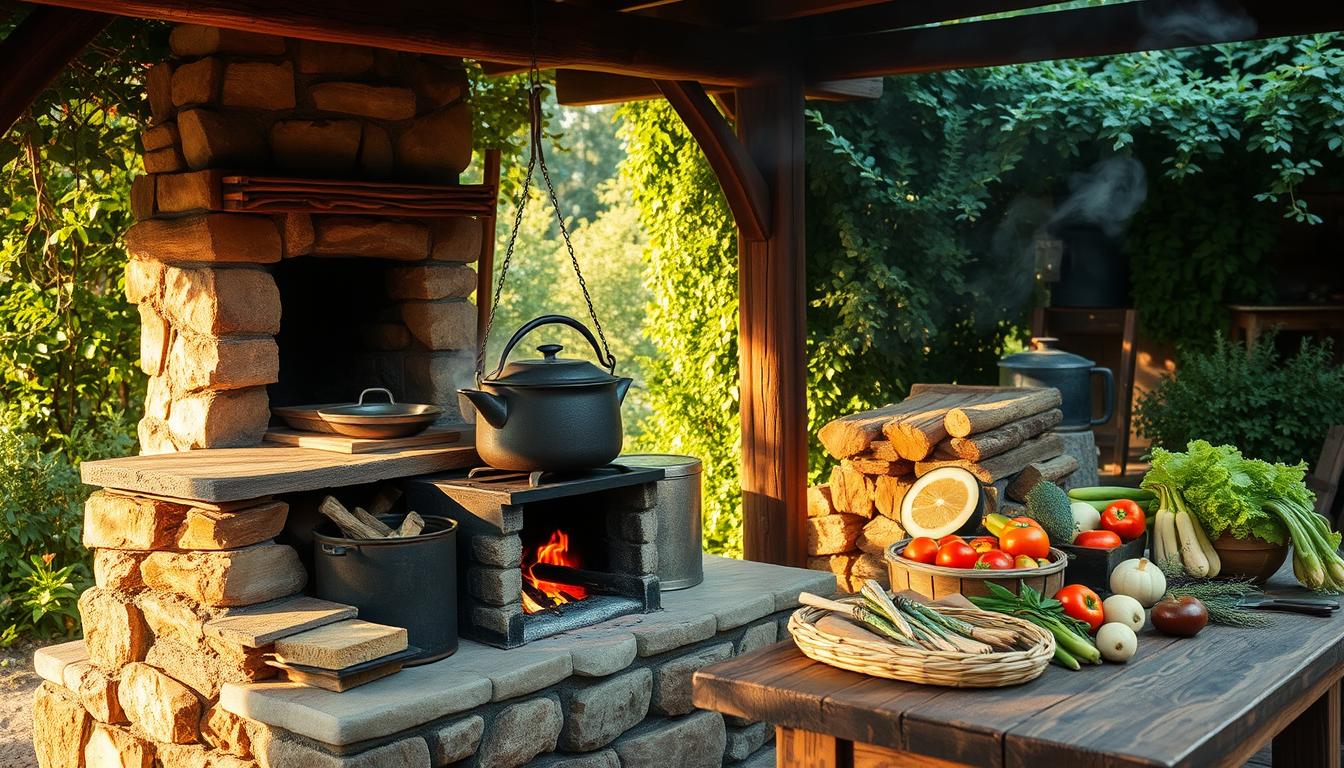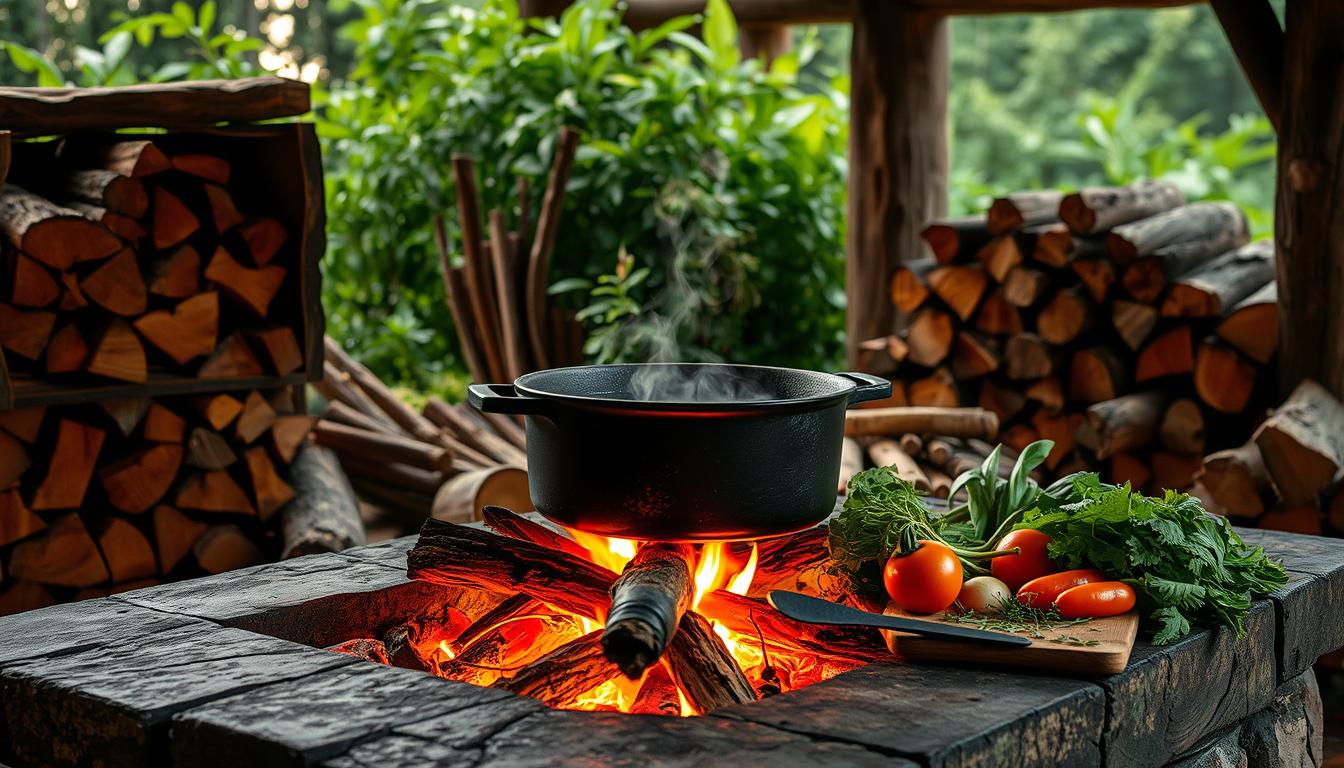Outdoor cooking has changed a lot. Now, it’s common in modern kitchens and backyards. People love the smoky flavors wood-fired cooking gives, thanks to heat logs.
Heat logs make cooking with firewood easier. They’re a great choice for those who want real cooking experiences. These logs are easy to use and don’t need a lot of space.
Cooking with firewood connects us to our past. It’s loved by chefs and backyard grillers alike. Heat logs make it easy for more people to enjoy wood-fired cooking.
Whether you’re an outdoor cooking pro or just starting, learning about firewood cooking can improve your skills. We’ll look at the techniques, benefits, and new ideas in heat logs for wood-fired cooking.
Understanding the Traditional Appeal of Cooking with Firewood
Cooking with firewood connects us to our ancestors. It’s more than just cooking; it’s a way to experience food with all our senses. From campfires to professional kitchens, it’s loved by many across the world.
Firewood cooking gives food unique flavors that modern methods can’t match. Different woods like oak, hickory, or apple add special smoky tastes. Chefs and home cooks love the challenge of mastering this traditional way of cooking.
Firewood cooking also brings people together. Since ancient times, sharing meals by a fire has been a social tradition. The sounds, sights, and shared effort make meals unforgettable and bond communities.
Those who cook with firewood know it’s a skill that needs patience, knowledge, and instinct. Controlling the fire, choosing the right wood, and managing the flames are key. Each dish shows the cook’s bond with nature and their culinary heritage.
The Science Behind Wood-Fired Cooking Temperatures
Cooking with firewood is more than a cooking method—it’s a science. The magic happens when different wood types create unique heat zones. This lets chefs cook food to perfect temperatures.
The Maillard reaction is key in wood-fired cooking. It happens when food meets high heat, changing its taste and color. Hardwoods like oak and maple keep temperatures steady, ideal for controlled cooking.
Knowing about heat zones is crucial. Some parts of a wood fire get very hot, while others stay cooler. Cooks move food between these zones to get the best flavors and textures. This natural heat variation is hard for modern appliances to match.
Choosing the right wood changes cooking temperatures and flavors. Fruitwoods add sweetness, while hickory brings smokiness. Chefs and home cooks love how different woods can make simple dishes taste amazing.
Comparing Heat Logs and Traditional Firewood
Cooking fans often talk about heat logs versus traditional firewood. Each has its own special qualities for cooking outdoors and indoors. Heat logs are made to burn well and give steady heat.
Traditional firewood gives a real cooking feel. It comes in types like oak, hickory, and maple, each adding its own taste. Heat logs, made from compressed sawdust and wood waste, burn evenly and leave little ash. They are loved for their clean burn and even heat.
Heat logs shine in controlled settings. They keep a steady temperature, great for precise cooking. Firewood, on the other hand, needs skill. Choosing the right wood and its moisture level affects the cooking. Campers like firewood’s natural taste, while home cooks prefer heat logs’ ease.
Thinking about the environment is key when choosing between heat logs and firewood. Heat logs are often better for the planet. They use wood waste and need less cutting down of trees. They also make fewer emissions and have a smaller ecological impact than firewood.
In the end, picking between heat logs and firewood depends on what you want to cook, your environmental views, and what’s practical. Both have their own benefits for those who love cooking.
Essential Equipment for Cooking with Firewood
Cooking with firewood is an art that needs special tools. Both professional chefs and home cooks use top-notch equipment. This gear helps bring out the unique flavors and cooking methods of wood-fired dishes.
Wood-fired ovens are key in firewood cooking. Brands like Ooni offer cast iron pizza ovens for great heat retention. Traditional clay tandoors and ceramic grills, like Big Green Egg, are also popular. They allow for smoking, roasting, and grilling with precise control.
Accessories are vital for safe and efficient firewood cooking. You’ll need strong fire starters, long tongs, heat-resistant gloves, and digital thermometers. Cast iron cookware is also essential. It distributes heat well and adds rich flavors to your dishes.
Choosing the right equipment depends on your cooking style, space, and budget. Portable grills are perfect for camping, while a permanent outdoor kitchen is ideal for home chefs. Quality tools make wood-fired cooking a rewarding and tasty experience.
Best Practices for Using Heat Logs in Cooking
Cooking with heat logs needs skill and precision. Professional chefs and outdoor cooking fans know heat logs are a reliable choice. They help control temperature and place logs correctly for great results.
Start with dry heat logs for cooking. Wet logs burn unevenly and cook less efficiently. Place logs to make different heat zones for direct and indirect cooking.
Managing temperature is key with heat logs. Preheat by arranging logs for even heat. Use a thermometer to check temperatures. Start with hot coals and add more logs to keep heat steady.
Good ventilation is important for cooking with heat logs. Make sure air flows well around your cooking area. Try different log setups to see how they change heat and cooking time.
Always be safe when cooking with heat logs. Have fire safety tools ready and cook in open areas. Watch your logs, removing ash and adjusting them as needed for perfect cooking.
Popular Dishes Enhanced by Firewood Cooking
Cooking with firewood turns simple meals into unforgettable dishes. Wood-fired cooking adds smoky flavors that regular kitchens can’t match. Pizza stands out, with its crispy crust and charred edges that truly capture the essence of firewood cooking.
Smoked meats are another highlight of wood-fired cooking. Brisket, ribs, and chicken soak up wood smoke, adding depth and complexity. Different woods like hickory, mesquite, and apple wood give unique flavors to meats.
Vegetable lovers will enjoy firewood cooking’s caramelization magic. Grilled veggies become sweet and charred, boosting their natural taste. Zucchini, bell peppers, and corn turn into gourmet treats when cooked over wood flames.
Bakers find amazing results with wood-fired bread and pastries. Artisan bread gets a crispy outside and soft inside. Pizzas and flatbreads gain textures that regular ovens can’t offer. Cooking with firewood brings a unique experience that connects us to ancient cooking traditions.
Sustainable Aspects of Modern Heat Logs
Heat logs are becoming a green choice over traditional firewood. They are made to be eco-friendly and efficient for cooking and heating. They use recycled wood and sustainable forestry to help manage resources better.
Producing heat logs cuts down on carbon emissions compared to regular firewood. Their compact design means they burn cleaner and more evenly. This leads to less waste and less harm to the environment.
Choosing heat logs made responsibly is a smart move for the planet. Many brands use wood waste or sustainably managed forests. This way, cooking lovers can enjoy their meals while helping protect forests.
Modern heat logs go through strict quality checks to avoid harmful additives. The making process aims for a clean-burning fuel that’s good for the planet. This makes firewood alternatives both useful and eco-friendly.
Knowing about the green side of heat logs helps people make better choices. As we become more aware of the environment, these wood fuels are a step in the right direction.
Seasonal Considerations for Wood-Fired Cooking
Cooking with firewood is a year-round adventure. Each season has its own set of challenges and opportunities. Summer is great for outdoor grilling, thanks to the sunshine and warm weather.
Fall is perfect for wood-fired cooking. The cool air makes the smoky flavors of food even better. Chefs can use seasonal ingredients like pumpkins and squash, which taste amazing when cooked over wood.
Winter cooking with firewood requires extra planning. Outdoor kitchens need protection from the wind and cold. Using hardwoods like oak or maple helps keep the fire going longer. Windbreaks and special cooking gear help keep the fire steady.
Spring brings unpredictable weather, which can affect cooking. It’s important to use dry, seasoned wood. Waterproof covers for cooking gear ensure meals are always delicious, no matter the weather.
To cook with firewood all year, you need to be flexible. Knowing how the seasons change wood quality and cooking conditions helps chefs make tasty meals anytime.
Storage Solutions and Maintenance Tips
Storing heat logs and firewood right is key to keeping them in top shape. It ensures they cook well. Dry wood, away from moisture, stops decay and pests. Use outdoor woodsheds or covered spots to keep wood dry and safe. Using a vedskjul or other covered outdoor storage is one of the best ways to keep wood dry and protected year-round.
Choose a spot for firewood with good air flow. Store wood off the ground to avoid getting wet. Make a neat stack that lets air through. For heat logs, sealed containers or bins keep them clean and dry.
Regular checks on your wood are important. Look for mold, bugs, or too much moisture. Use the oldest wood first and clean your equipment after each use. This stops fires and keeps things running smoothly.
Seasonal changes mean you need to rotate your wood. Keep seasoned wood near your cooking spot. Use covers in wet weather and make sure air can get in to avoid moisture.
Always think about safety when storing wood. Keep wood away from your house and clear around it. Follow local fire safety rules for storing wood.
Conclusion
Cooking with firewood is more than a cooking method. It’s a journey into tradition, flavor, and connection. Heat logs have changed the game for those who love wood-fired cooking. They offer a simpler way to enjoy this experience without the hassle of traditional firewood.
The art of cooking with heat logs combines old wisdom with new convenience. It works in everything from rustic pizza ovens to backyard grills. These logs give off consistent heat and smoky flavors that make simple dishes unforgettable.
For those eager to try new cooking techniques, heat logs are a great starting point. Brands like Lektowood offer high-quality options that make it easy and eco-friendly to cook with firewood. Whether you’re a pro chef or just starting out, this method can change how you see cooking.
Starting your wood-fired cooking journey means each flame has a story to tell. It’s about tradition, innovation, and our deep connection to cooking with nature. Choosing the right heat logs or firewood opens up a world of culinary creativity for you to explore.































